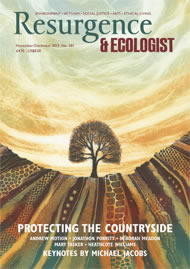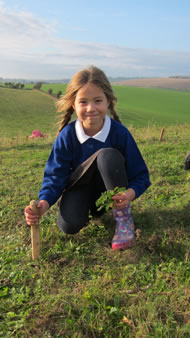When I first started the Earth Restoration Service charity, with the aim of enhancing and restoring ecological integrity, I had successfully managed to source and gather thousands of native trees and wild flowers to be used for restoration before there was a degraded area of land available to restore. I thought it would be straightforward to get access to land where I lived, as degraded and derelict areas could be seen everywhere. But after many magnificently failed calls with local councils, I realised this was more difficult than I had anticipated.
I gave up contacting councils and MPs and decided to look into how to engage my local community. I wanted to see where the heart of the community would be, a watering hole where those meeting up do not necessarily share the same views, yet interact. Those are engaging places. I discovered that schools come closest to what I was seeking: they occupy a central role that few other organisations or groups can reach. Could schools start teaching about ecological restoration and at the same time begin to transform derelict land into woodland?
The idea was idealistic at first, but by planting a tree nursery inside the school gates, the school could easily combine an educational and a practical planting programme. The children could care for the trees, and once those trees had matured they could be planted out in their community with the help of parents and teachers. Parents liked the idea, and most people I spoke to supported it. It grew to become the School Tree Nursery Programme.
The motto is that trees have to be planted in our minds as well as in the soil – bringing together education and practical environmental restoration is the central axiom of the work. Since it started with just one school signing up in 2007, the demand has grown and the programme has spread to over 400 schools nationwide and to other countries, including India, Ecuador and Tanzania.
I am pleased to report that many of the participating schools are from deprived areas in the UK and that some schools with limited outdoor space have used creative ways of planting tree nurseries up against the walls in raised beds and of finding small places to fit the saplings in, to the joy of their pupils.
The trees have also been used for the restoration of floodland, eroded countryside and neglected inner-city areas, and I have witnessed how this has united and encouraged schools to participate in resolving where to best plant the saplings for maximum benefit to the local environment.
By involving schools, I have not had a single problem with planting out the trees or finding land. Instead, many MPs have joined in the work themselves. One bright example comes from the Andover area, where a community of 25 local schools brought their tree nurseries together to plant out seven acres of new woodland, all for the recreational benefit of the children living there and for the wildlife. Every young person in the Andover community will have helped to plant 10,000 trees over the next decade.
Other notable projects have been memorial woodlands created by students with learning difficulties, and numerous wildlife corridors in partnership with the Wildlife Trusts across the country. Children, parents and teachers have planted out over 100,000 trees in the past five seasons, corresponding to roughly 1,000 new woodlands.
Ecological restoration by definition is positive and life-affirming; with our hands we garden in the very mosaic of Nature and enter into a caring relationship. With localised planting programmes, alongside educational talks and workshops, children learn about the ecology of their immediate surroundings whilst leaving their own legacy in the landscape. The educational value of tree planting should not be underestimated. If a child can learn how to plant trees and understand how they live and why they matter, I am certain we will have a new generation of millions of Wangari Maathais.
With the UK’s history of deforestation (as destructive as any in the Amazon or Indonesia), only 12% of land remains wooded, a pitiful proportion compared to the rest of Europe. We can turn this current trend around and increase this percentage in the next 20 years. There are agricultural policies standing in the way, as well as the lack of initiatives and demands from communities. But tree planting remains a cost-effective way of enhancing the landscape. Despite the challenges, I have seen signs of recovery and a better view of restoration from the general population.
We should remind ourselves that trees and truth have the same etymological base: they are united at the root. This is not surprising, as trees are the real governors of the land; they regulate our air, filter the soils, provide habitats and food for wildlife; they supply us with homes, heat and timber.
In Scandinavia, care trees were planted in farms and homesteads, symbolising the World Tree (Yggdrasil), and porridge would be laid out as a gift in the festive season to remind people to say thanks for all the things trees give us. By taking care of the local tree (microcosm) we also took care of the World Tree (macrocosm). The care tree was a figurative expression of interdependence, representing Nature as a whole.
For all the machinery and all the engineering humankind possesses, in a single seed lies the power to restore the whole Earth. All we have to do is to allow the seed to grow and flower. Hope is waiting to sprout under our feet.
Schools interested in starting a tree nursery this coming season can email [email protected] www.earthrestorationservice.org








